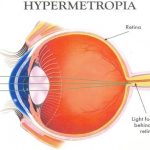Hyperopia
 In hyperopia, the eye is shorter than with a normal eye. Depending on the age of the patient this condition can be adjusted by means of accommodation of the eye, so that a clear picture can still be transmitted to the brain.
In hyperopia, the eye is shorter than with a normal eye. Depending on the age of the patient this condition can be adjusted by means of accommodation of the eye, so that a clear picture can still be transmitted to the brain.
The younger the person is, the better he or she can accommodate. The normal eye only needs to accommodate for near vision, and is already far-sighted for distance. The accommodation and the convergence setting of the eyes are coordinated. Since the normal eye accommodates for near vision, hyperopia can lead to a convergent strabism, if not corrected. Such a squint in early childhood can lead to a unreversible visual weakness in one eye (amblyopia). Diagnosis and treatment in early childhood is therefore extremely important. Adults without treatment can suffer from headaches, typically during the day after prolonged visual strain. Hyperopia causes more problems when dealing with near distance than with far distance.


